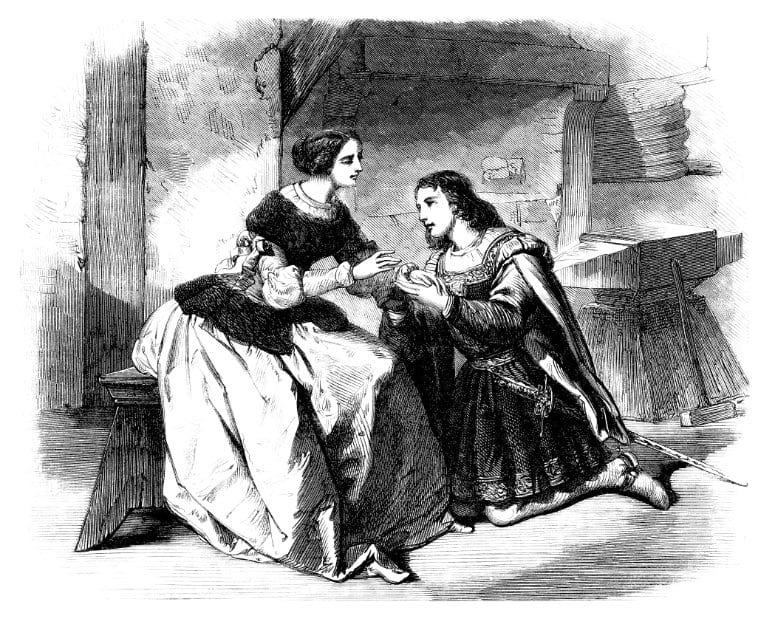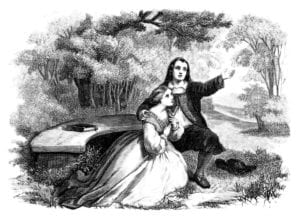Introduction
There is nothing else like this poem in Shakespeare’s work. His long poems “Venus and Adonis” and “The Rape of Lucrece” are lucid narrative pieces, whose leading characters are as finely drawn as the characters in his plays. Here, by contrast, is an enigmatic poem in which (from the critic’s angle) almost everything is a matter of speculation and conjecture.
That being so, it’s worth identifying what we do know for certain about this poem. It was published in 1601 in a volume of poems by various authors, chiefly Robert Chester, of whom (again) little is known. The book was entitled “Love’s Martyr or Rosalins Complaint”, and subtitled “Allegorically shadowing the truth of Love, in the constant Fate of the Phoenix and Turtle”.
Shakespeare’s poem, 68 lines long, describes the death of the love shared by the phoenix and the turtle-dove, and it gives Reason’s reaction to this love. Needless to say, the poem is allegorical, and that matters because Queen Elizabeth routinely used the phoenix to refer to herself. Shakespeare uses the same image to refer to the infant Elizabeth in “Henry VIII”.
More or less everything else about this poem is disputed.
Details of Publication
In 1601, two years before the death of Queen Elizabeth, Robert Chester published a lengthy poem called “Love’s Martyr”, in which a history of Britain from Roman times is interwoven with an exploration of the symbolism of the phoenix and the turtle-dove. The phoenix was Elizabeth’s chosen symbol for herself.
This long poem was accompanied by a variety of shorter lyrics by distinguished poets of the day, including Ben Jonson. These poems also explore the symbolism of the phoenix and the turtle-dove. About Robert Chester, almost nothing further is known, so it is impossible to say why poets of Shakespeare’s distinction chose to publish their work in this way, if indeed they did choose.
One possible connection may be Sir John Salusbury, a Welsh knight with powerful if problematic connections. Salusbury, who was knighted in 1601, may have numbered Chester among his employees – a poem by Chester has been discovered in the Salusbury family archives. His knighthood reflected his opposition to an attempted coup launched by the Earl of Essex, a former intimate associate of the Queen.
However, whether any of this bears on the poem itself is another matter.
Elucidation
The poem divides into three sections. In the first, which runs for the initial twenty lines, an announcement is to be delivered by “the bird of loudest lay” or song. The announcement will be “sad”, and is intended only for birds that are “chaste” or virtuous. It is possible that the bird making this announcement is a phoenix (perhaps a reborn version) since this bird is commonly depicted in a palm (or “sole Arabian”) tree.
There now follow two lists: those birds to be excluded from this announcement include the owl or “shrieking harbinger” (who is enjoined to “come not near”) as well as “Every fowl of tyrant wing” or birds of prey. Birds to be included are specifically “the eagle”, the “death-divining swan” (dressed like a priest in “surplice white”) and the crow, attired appropriately in mourning “sable”, a bird believed in Shakespeare’s day to reproduce itself through its breath.
The second section, beginning at line 21 (“Here the anthem doth commence”) and ending at line 40, outlines the trigger for the announcement: the love between the phoenix and the turtle is at an end, apparently burned in “a mutual flame”.
The five verses that follow describe an ideal of love in which separation and isolation are dissolved. In the poem’s seventh verse (beginning “So they loved….”), the poet discerns “division none” between the “two distincts”. In the eighth, even physical distance cannot separate the lovers: “Distance, and no space was seen / ‘Twixt the turtle and his queen”.
The ninth verse sees the lovers as “the other’s mine”, each infinitely resourceful and available to the other; verse ten says that selfhood or individual identity – Shakespeare uses the word “Property” – was “appalled”, offended by love’s selfless instincts. This sense of love’s transcendent properties anticipates John Donne’s celebrated “A Valediction: Forbidding Mourning”, written a decade later.
The ability of love to outwit natural boundaries – of identity, of distance, of space – puts it beyond reason, and the eleventh verse describes a personified Reason as “confounded”. This is the third stage. In particular Reason is presented as being confused by love’s logic, its ability to ensure that “what parts [or divides] can so remain [stay connected]”.
Inspired or perplexed by its discovery, Reason composes the “threne” or Threnos with which the poem closes. A Threnos is a lament for the dead, and the closing five verses are notable for their disillusioned tone. The demise of the love shared by the phoenix and the turtle is underlined in each of the five verses.
In the first verse, all virtues now “in cinders lie”. In the second “Death” and “eternity” are their companions. In the third, “no posterity” is left. In the fourth, “Truth and beauty” are “buried”. In the fifth, all one can do is “sigh a prayer”. This conjunction of love with death is a theme Shakespeare revisits around a decade later, in “Cymbeline”: “All lovers young, all lovers must / Consign to thee [i.e., death], and come to dust”.
Interpretation
The phoenix and the turtle-dove are allegorical figures, whose identities may have been known to some of Shakespeare’s readers, but not all. That being said, the phoenix was a well-known symbol for the Queen. When she came to the throne in 1558, a coin was issued which featured Elizabeth on one side, a phoenix on the other. In Nicholas Hilliard’s “Phoenix Portrait” (c 1575), she wears a phoenix jewel suspended from a pearl necklace. In 1596 a further portrait shows the Queen with a burning phoenix behind her, presumably about to rise from its own ashes. In 1601 she is described as a phoenix in Parliament. In Shakespeare’s Henry VIII (c 1612), Archbishop Cranmer compares the infant Elizabeth to a “maiden phoenix”. So at least one couplet from the poem may perhaps be read literally: “Distance, and no space was seen / ‘Twixt the turtle and his queen”.
If the Queen is the phoenix, who is the turtle-dove? As symbols of innocence, purity, fidelity and enduring commitment, this bird carries a lot of weight in a poem about love. The most arresting interpretation places the Earl of Essex in the place of the turtle-dove. A favourite of the Queen for many years, he had led a rebellion against her rule in February 1601 and been executed for his impudence. If he is the intended “signified” then at least the poem is topical.
A second candidate is Sir John Salusbury, who had been knighted in 1601 as a reward for his help in putting down the Essex rebellion. A third candidate is the kingdom over which Elizabeth ruled and to which the Maiden Queen devoted herself, forsaking all others.
Or it may be none of the above. After four hundred years, it is perhaps idealistic to expect an answer – unnecessary too. The poem – simultaneously a love poem though not addressed to a lover; a public poem though not intelligible to a wide public; and a narrative poem (“Whereupon” etc.) without a narrative – is a remarkable piece in its own right, anticipating (inter alia) the work of such twentieth century writers as W.B. Yeats and W.H. Auden.





One Response
Hello, This poem is obscure because he is referring to an event in pre-history.
He is talking about the fall of man, Which wasn’t instigated by man kind, It was instigated by the animal soul of humanity.
It was an event that was instigate pre-time, Pre-law, It was a crime of pure devotion to the pursuit of the word of god.
A crime that was not a crime, It happened pre-law, pre-time, This event heralded the arrival of number and law to accompany word.
It is a plea for help for the instigators, It is only addressed to those who are “chaste” and excludes those who are predatory and destructive because the rectification of this problem requires those who are attempting to rectify this issue to hold to the perspective that crystallises the knowledge that those responsible are still alive today and are still ascending, falling and decimating the earth in a fury be cause we are reliving this event throughout time until it can be rectified or their is no-one left to rectify it and we are all annihilated because we failed to accept that those who instigated this are ultimately innocent of their crimes in the eyes of god, Even though the are currently responsible for 100% of the problems that humanity are currently being crushed by, Every cataclysmic event that has befallen humanity is because of a knot in the psyche of humanity that opens up the possibility of a rapid ascent to enlightenment by those same people, Which is immediately followed by a descent, Enlightenment is to much for doves.
The prayer is a request for help, forgiveness, understanding, amnesty, protection from those who understand there brilliance as well as their innocence, Corrupted.
The mistake was gods, And those who were chasing those birds.
Not shakespear, Shakes-peer.